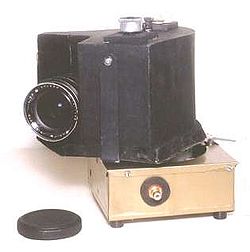
Leme panoramic camera
Encyclopedia



Marília
Marília is a Brazilian city and municipality in the midwestern region of the state of São Paulo. Its distance from the state capital is by highway, by railway and in a straight line. It is located at latitude 22º 12'50 "south and longitude 49º 56'45" west, with an altitude of 675 meters...
, São Paulo
São Paulo
São Paulo is the largest city in Brazil, the largest city in the southern hemisphere and South America, and the world's seventh largest city by population. The metropolis is anchor to the São Paulo metropolitan area, ranked as the second-most populous metropolitan area in the Americas and among...
, Brasil.
In 1957, an entrepreneur requested a picture of his buildings, which stood at three of the corners of a street-crossing, and he wanted to show the group of buildings in one single photo, which would have to cover 360°. Using a Rolleiflex
Rolleiflex
Rolleiflex is the name of a long-running and diverse line of high-end cameras originally made by the German company Franke & Heidecke, and later Rollei-Werk. The "Rolleiflex" name is most commonly used to refer to Rollei's premier line of medium format twin lens reflex cameras...
with a panoramic head, ten negatives were taken that, enlarged and mounted, resulted in a 360° photo. Leme then addressed the challenge of taking a 360° photo in a single negative.
The demonstration of his eventual solution consisted of a lens mounted in a small, empty tomato purée can, an internal device which is the principle of the invention, and a piece of film fixed inside the can. He tested it in front of the Senai building by rotating the lens by hand. The film, when developed, precariously confirmed that it was possible to take 360° photos.
The first prototype was entirely mechanical. Three prototypes were made, and they were improved over one year. In the meantime, sure of having found a solution to the problem of taking 360° photos, Leme applied for a patent registration, a process that went on for some years.
On April 23, 1962 the patent was awarded under No. 61.472. About 20 years after the patent was awarded, a similar system appeared in the United States
United States
The United States of America is a federal constitutional republic comprising fifty states and a federal district...
, but without the internal device mentioned above. The camera remained out of use for 15 years. At the end of 1997, it was taken up again, improved, and put to use once more.

